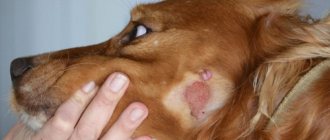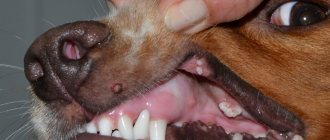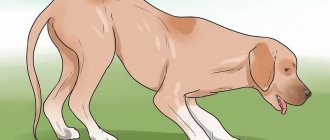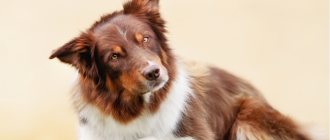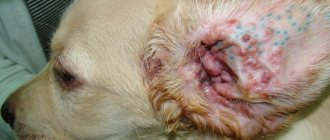A dog's skin is a dense and durable outer shell of the body, which sooner or later can be affected by fungus. Young pets with weak immune systems and pets that have been poorly cared for are at high risk of contracting fungal diseases. Dogs with poor heredity and special individual characteristics of the body are also vulnerable to fungal dermatitis.
Fungal diseases in dogs are accompanied by destruction of the skin, resulting in poor health of the animal. It is important to identify the fungus in a dog in a timely manner and not delay treatment. When the first signs of fungal dermatitis appear, you should immediately seek help from an experienced veterinarian.
Causes of the disease
All fungi are divided into two types:
- Pathogenic (microsporum, trichophyton, favus). A dog can catch the “infection” from sick dogs on the street or from its owner who brought fungal spores on the soles of shoes, clothes or hands.
- Opportunistic (mallasesia, candida yeast). They are always present on the body of animals, but under certain circumstances their quantity goes beyond acceptable limits, turning into a pathology. Not contagious to others
The source of increased sensitivity to fungal infections is most often problems with the immune system. Young puppies and old dogs with poor health and impaired immune systems are prone to dermatophytosis. The body's resistance also decreases after taking antibiotics and other potent drugs.
The following can be added to the provoking factors:
- Tendency to allergies and colds.
- Excessive hygiene, for example, bathing several times a week using antibacterial shampoos, leads to a decrease in the protective functions of the skin and the growth of opportunistic fungi.
- Insufficient hygiene. Under matted hair and uncombed tangles, the skin breathes poorly, which also contributes to the active activity of fungi.
- Lack of adequate nutrition.
Causes and methods of infection
Fungal diseases that occur in dogs are caused by two types of fungus - pathogenic and opportunistic.
Pathogenic fungi are dangerous microorganisms that, after contact with the skin, penetrate into it and begin to develop. The main carrier of the pathogen is sick animals, after contact with which dogs even with strong immunity become ill.
Spores of pathogenic fungi remain in the soil, sand, grass, and even dust for a long time. You can catch them simply by walking through an infected area. In addition, spores can be brought by the owner on shoes or clothes, and a dog can get sick even when not walking outside. Pathogenic fungi are dangerous because some of their varieties are infectious to humans.
Opportunistic fungi always live on the skin or fur of an animal. In small quantities they are not dangerous and do not cause concern. Yeast is an example of this. In dogs of any breed, yeast is an integral part of the microflora. But if an animal’s immunity decreases, it is weakened after some disease or improper maintenance, a favorable environment is created for their reproduction. Opportunistic fungi not only spread over the surface of the skin, but also penetrate into deeper layers.
Forms of fungal diseases
There are three main types:
- Superficial. The fungus is localized on the surface layers of the skin and mucous membranes. Typically these are the ears, nose, area around the mouth and between the toes. These include Malassezia dermatitis and candidiasis.
- Subcutaneous. As the disease progresses, the infection spreads to the deeper layers of the skin, corroding the tissue. Such fungi include sporotrichosis.
- System. They affect internal organs and are difficult to treat with medication, therefore, most often, problem areas are excised surgically. This includes histoplasmosis and aspergillosis.
Clinical picture
Symptoms of fungal infections depend on the type of irritant that caused the pathology. If we try to reduce all the signs to a single denominator, we get the following picture:
- First, small spots of different diameters appear on the skin. The fur in these places gradually thins, and the hairs themselves either fall out or break off at the root.
- In the affected area, the skin changes color - turns red or gray. Depending on the intensity of the disease, the spots can quickly spread to nearby areas of the body or, conversely, remain in a “frozen” state for a long time.
- Whitish sacs form on the roots of the hair, enveloping the bulb. Scales and flakes appear, which are abundantly separated from the skin and fall off.
- Over time, large bald patches form, the skin thickens, becomes crusty, and the fungus itself eats away at the tissue.
- The dog experiences constant itching. Its intensity can vary: from light scratching to uncontrollable scratching of the skin until there is blood.
Fungus on a dog's face
Important: to alleviate the animal's condition, you can use the drug Stop Itching or some equivalent, and treat areas with scratches and microtraumas with antiseptics before visiting the doctor - Miramistin, Migstim-spray. It is also recommended to wear a protective collar on your dog.
The most common places for fungus to develop are the paws and between the toes, as well as the ears.
- If we are talking about the interdigital space, the clinical picture is characterized by coarsening of the skin around the nails and paw pads, yellowing of the claws and their curvature, as well as the presence of inflamed crusts and scales. Typically, the fungus makes itself felt in the off-season: in spring and autumn, when the weather is unstable and wet. The dog begins to chew its fingers, itches, limps, or is generally afraid to step on the sore paw.
- The inner surface of the ears and the pinna are another “favorite” place for the fungus. It is not difficult to recognize - an unpleasant odor emanating from the ear, crusts and rough skin, discoloration, inflammation. The dog is constantly nervous and tries to scratch itself, shaking its head. As a rule, ear fungus is more a consequence, rather than an independent disease, in various forms of otitis media, allergies, mites and bacterial infections.
Symptoms
Each type of pathogenic fungus manifests itself differently. Common signs of mycosis in dogs:
- the muzzle and paws are covered with bare round spots, with gray scales;
- pustular rashes;
- the whole body is covered in scaly bald spots.
The first thing you need to pay attention to is the appearance of gray or red spots of 1-4 cm with dandruff, which are difficult to notice under the fur. As the affected areas increase in size, they begin to become bare, the dog loses weight, suffers from severe itching, inflammation and ulcerative wounds form. Paws and claws hurt. The mucous membranes are covered with a white coating. If the parasite gets inside, diarrhea begins and pneumonia develops.
Diagnostics
The initial examination is usually carried out with a Voodoo lamp - a device with a special backlight, in the rays of which the fungus appears green. However, it is worth considering that it is impossible to identify the type of fungus in this way. Moreover, the presence of a fungal infection can only be confirmed in about 60%, plus sparks are often confused with dust and other contaminants.
For an accurate diagnosis, the doctor takes scrapings from the affected areas, followed by culture in the laboratory. And only after accurately identifying the pathogen can a treatment regimen be drawn up.
Fungus on a dog's paw
Additionally, the following studies may be prescribed:
- Blood test for bacteriology. This is done in order to refute or confirm the dog’s sensitivity to cocci and other bacteria. Alternatively, the animal may “get” the fungus as a secondary infection, and the original source of the problem will be different.
- Blood test for different types of allergens. If the body reacts to an allergy with a skin fungus, then even after treatment, the symptoms will return again. To avoid falling into a vicious circle, it is necessary to identify the causative allergen and eliminate it.
- Detailed blood test. This is done in order to get a general picture of health, since dogs with weakened immune systems are primarily at risk.
How can a dog get a fungal infection?
The ways in which a dog becomes infected with a fungal infection can be very diverse, but most often pathogenic microorganisms are transmitted from a sick animal to a healthy one through personal contact. In addition, the source of the problem can be the bowls, toys and sleeping place of a sick pet, and in some cases the owner brings the pathogen into the house on his shoes and clothes. When walking your dog, it is better to choose places where other animals rarely appear, since the fungus can persist on the soil and grass for some time.
Important! The incubation period for infection with a fungus ranges from 4 days to a month, so it is almost impossible to determine exactly where the pet could have become infected.
Treatment
Treatment regimens are mostly standard, but take into account the identified type of fungus and the complexity of the disease. Medicines are available in different forms and can be combined with each other during use.
- Antifungal shampoos - Nizoral, Ketoconazole, Imaverol. It is used both for therapeutic purposes and as prophylaxis. It is effective in cases where there is extensive damage to the skin, as well as after contact of the animal with infected dogs, swimming in open water, walking in nature, etc.
- Antifungal sprays - Fungin, Zoomikol. Spray locally onto diseased areas of the skin. Recommended for use on long-haired dogs, as they have good penetrating ability.
- Antifungal ointments - Yuglone, Clotrimazole, Yam. Apply to the affected area, as well as slightly beyond its perimeter. To enhance the effect of the drug, it is advisable to cut the hair at the treatment site. If necessary, apply a bandage.
- Birch tar. A time-tested folk remedy that gives a good effect in untreated cases. Has a strong unpleasant odor. It dries wounds and deep scratches well, fights fungus and eliminates itching.
- Antifungal vaccination. The most common vaccines are Vakderm, Microderm, Polivac. Used as subcutaneous injections in 2 stages with a break of 2 weeks. Some breeds may develop an allergy to the vaccine with the formation of temporary inflammation or even an abscess at the injection site.
Important: if the identified type of fungus is contagious to humans and other dogs, then the pet must be treated with gloves. It is also necessary to take care of isolating the animal during the treatment period.
Subcutaneous forms of fungal infections, as a rule, occur with complications and therefore require more intensive therapy. If conservative treatment does not produce positive results, surgical excision of the affected tissue is performed. In advanced cases, even amputation of limbs is possible.
For systemic pathologies, the following drugs are prescribed:
- Amphotericin B;
- Griseofulvin;
- Potassium iodide;
- Thiabendazole.
In parallel, compensatory therapy is carried out to relieve intoxication, which includes intravenous administration of glucose, saline solutions, and calcium glucanate. Additionally, medications are prescribed to restore the cardiovascular system, gastrointestinal tract, and lungs. Quite often, the treatment regimen includes taking antibiotics, since fungal infections are the result of a disturbance in the bacterial flora.
To maintain immunity, it is recommended to take immunoglobulins, and if finances are available, special hyperimmune serums.
Types of fungi in dogs
Another big problem is that many types of fungi are completely harmless under normal conditions. Their “abilities” are activated only by an extremely unfortunate combination for a dog of an extremely weakened immune system and other factors.
Another (and also extremely unpleasant) feature of fungal infections is their very high tendency to recur. Even when a dog seems completely healthy, it is not at all a fact that he will not get sick again in a couple of months (or even earlier).
Aspergillosis
Aspergillosis is a mycosis, and its causative agents include several fungi from the genus Aspergillus. The disease is widespread throughout the world, affecting not only dogs, but also other animals (domestic and wild).
In typical cases, the infection affects the respiratory tract, but there are frequent cases of its generalized course, when the fungus affects the surface of all skin and even internal organs. Susceptibility to it varies depending on the breed of the dog, its physiological state, and other factors. Thus, dogs kept at home and well fed get sick much less often than their stray counterparts.
Aspergillosis of the nasal cavity
As we have already said, in typical cases the pathogen affects the organs of the respiratory system. More precisely, the mucous membranes of the nasal cavity and many sinuses of the skull. This disease is very common in dogs. The danger of the fungus is that it develops very aggressively, and in advanced cases the pathogen destroys not only the mucous membranes and other soft tissues of the nasal cavity, but also the bone base. There are known cases of damage even to the eye sockets, and ear aspergillosis is also known.
Unlike many types of mycoses, which primarily affect animals with initially weakened immune systems, aspergillosis can affect completely healthy pets, effectively suppressing the reserves of their immune system. The route of infection is respiratory, i.e. The dog becomes infected by inhaling air or dust with spores.
Interesting! Nasal aspergillosis is primarily seen in dogs with long, narrow heads and noses (collies and greyhounds, for example).
Symptoms of infection include: bloody discharge from the nasal passages, pain (manifested when trying to palpate the nose), constant sneezing, ulcers on the nasal mucosa. In especially severe and advanced cases, profuse nasal discharge is characteristic. In them, in addition to mucus, it is easy to see pieces of soft tissue and even small bone fragments. Despite this, diagnosis is not particularly simple.
Nasal aspergillosis is treated with a combination of surgical debridement (i.e., removal of all destroyed tissue) and drug therapy. The likelihood of relapses is quite high, but after proper treatment they occur infrequently.
Disseminated aspergillosis
Disseminated aspergillosis is considered a specific disease of German Shepherds. Compared to the usual nasal form, this variety is characterized by a greater tendency to generalize. Researchers suggest that the route of infection is exactly the same as in the previous case: the animal must inhale fungal spores (which is why growths often appear on the nose), or a foreign body contaminated with them enters its nasal cavity.
The pathogen gradually “moves” from the nasal cavity to the lungs, and from there it enters the general bloodstream. After this, the fungus easily and quickly spreads throughout the dog’s body, including the intervertebral discs of the spinal column, eyes and kidneys. However, this does not in any way eliminate the possibility of damage to other internal organs and tissues.
Disseminated aspergillosis is characterized by slow but “sure” development. As a rule, this takes several months.
Symptoms of this disease include: pain in the lumbar region, which is easy to identify even with mild palpation, stiffness of the animal, which manifests itself even after short physical activity. Soon the disease progresses, and the dog develops complete or partial paralysis of the limbs (usually the hind limbs). Other, less definitive, study findings include poor appetite, weight loss, muscle wasting, fever, weakness, lethargy, vomiting, eye inflammation and enlarged lymph node.
Important! Severely ill dogs have a poor prognosis. Most dogs die from disseminated aspergillosis, although some have been treated successfully.
Chromoblastomycosis
In foreign veterinary periodicals the name Phaeohyphomycosis is more common. The causative agents are fungi from the Dematiaceae family. Infection occurs when damaged areas of the skin are directly contaminated with spores of a pathogenic fungus.
This skin condition is relatively uncommon in dogs. The typical course of the disease is characterized by damage to the skin of the extremities and abdomen (as well as the genital area). Nodules may form on the head, nasal mucosa, and chest.
As a rule, fungi accumulate only in these nodules, and therefore surgical therapy has proven itself to be excellent. This disease is distinguished by the fact that the real need for long-term administration of antifungal agents is really rare. In addition, regular tar soap helps a lot and should be used to wash the animal regularly.
Rhinosporidiosis
This is a chronic infection that primarily affects the mucous membranes of the nasal cavity and, much less frequently, the skin. The causative agent is the fungus Rhinosporidium seeberi. For our country, this pathology is not very common, but is often found in Asian countries. From there, the pathogen often enters the territory of the Russian Federation.
The disease is expressed in the appearance of peculiar polyps on the surface of the nasal cavity. They are characterized by a soft consistency and pink color, have a “crumbly” surface on which the lobules are clearly visible. On palpation, a rough outer texture is felt. Polyps can be isolated, but there are often cases when they cover large areas of mucous membranes and even skin.
The main method of treatment is surgical excision of tumors. Antifungal agents are prescribed relatively rarely. The probability of relapse is quite high.
Mycetomas
Mycetomas is the general name for a huge number of fungal infections, accompanied by the appearance on the skin or in the thickness of the subcutaneous tissue of swellings and pustules filled with pathogen spores and remnants of corroded tissue.
Important! The danger of mycetomas lies in the fact that they can form in literally any organ or tissue of the dog’s body, including vital ones.
When tumors of fungal origin are just forming, they are easily confused with papules that appear as a result of some kind of bacterial infection, but subsequently they are filled with dense, curdled contents. Granules can have different colors and sizes, it depends on the specific type of fungus that causes their appearance. Fortunately, mycetomas are not very common in dogs.
Interestingly, in cases where they do appear, most of the swellings are located on the lower part of the body. They are usually noticed on the paws and belly. Sometimes the muzzle is affected. When many mycetomas are located on the legs (more precisely, between the toes), this is not at all good: gradually they can grow directly into the thickness of the bone tissue.
Growths on the face are a reason for an immediate visit to the veterinarian. If they are located on the lower abdomen, the mushrooms usually do not show such a desire for “expansion” (but there is always such a possibility).
This pathology is treated with a combination of surgical and drug therapy.
Desert disease (aka Coccidioidomycosis)
Coccidioidomycosis is a non-contagious infection caused by the fungus Coccidioides immitis. The latter enters the body exclusively through inhalation of spores. The disease received its second name because it was originally widespread in the arid regions of the USA, Mexico, and also in some regions of South America.
The only known route of infection is inhalation of spores. Currently, the infection occurs in almost all desert and hot areas of the world, and there are cases of infection in our country. True, this disease is in any case uncharacteristic for dogs.
The disease in most cases occurs in the form of chronic inflammation of the respiratory system. In dogs, oddly enough, numerous skin pathologies are simultaneously observed (tumors under the skin, abscesses, dermatitis and eczema of unknown etiology).
Characterized by intermittent fever, partial or complete loss of appetite, and progressive weight loss. Less commonly, difficulty breathing, lameness, neurological seizures and eye diseases are noticed in a sick dog.
Diagnosis is based on microscopic examination of tissue samples from a sick pet.
Treat the infection with long-term use of oral antifungal medications. The forecast is cautious. It has been observed that dogs in which the disease manifests itself in the form of skin diseases respond better to treatment. There is no specific prevention.
Candidiasis
Localized pathology of fungal etiology, affecting the skin, as well as the mucous membranes of the respiratory system. As in the previous case, not only dogs, but also other types of domestic and wild animals get sick. The causative agent is a species of the fungus Candida albicans. Candidiasis is common in dogs.
It is usually secondary to infectious diseases of the oral cavity, respiratory system, intestinal and bladder diseases. Sometimes ophthalmological pathologies develop. Predisposing factors include any wounds and skin abrasions.
Any injury to the mucous membranes is dangerous. It happens that attempts at “treatment” with folk remedies lead to its appearance. Long-term use of antibacterial agents and anti-inflammatory corticosteroids also does not end well.
Symptoms are also vague and depend on which organ system is affected. Characterized by diarrhea, weakness, skin lesions. However, the entire clinical picture may primarily indicate a primary disease that contributed to the development of candidiasis.
The disease is treated with a combination of topical and oral antifungals. Remember that one therapeutic course may take a couple of months. In general, the latter is typical for all fungal infections. Sometimes even a year’s course of treatment is not a guarantee of ideal dog health.
Dermatomycoses
A large group of diseases, the second name of which is known to all animal lovers. This, of course, is lichen. As a rule, these diseases are caused by pathogenic fungi of the genus Microsporum. The undisputed leader is Microsporum gypseum. Not much less often, dog lichens are caused by the action of the fungus Trichophyton mentagrophytes. Diseases are characterized not only by their diversity. They have two other features.
The first is their high virulence. Thus differing from other fungi, which under normal conditions may not cause disease, the same Trichophyton mentagrophytes is certainly a pathogenic microorganism. If an animal's immunity is even slightly less than ideal, fungal spores will almost certainly germinate and cause the development of disease.
The second feature (even more unpleasant) is low species specificity. Simply put, the type of mammal is not particularly important for these parasites. They can equally cause disease in dogs, cats... and people, of course.
Considering that lichen is easily transmitted to humans, never forget about at least the basic standards and rules of personal hygiene.
It is interesting that the causative agents of many lichens choose rather deep layers of the skin as their “home”. Fortunately, these fungi do not show a tendency to germinate into muscle tissue and internal organs (even with a severe infection process). Severe cases are characterized by damage to the claws.
If you notice signs of infection in time and begin a therapeutic course, there is no particular danger to the animal’s health. Please note that all dermatomycoses (like other fungi) are especially dangerous for pets whose immunity is for some reason suppressed or initially reduced.
Do not forget that a vaccine against lichen was created long ago and is being used effectively.
Sporotrichosis
It is a sporadic chronic disease caused by the fungus Sporothrix schenckii. Found all over the world, the natural substrate is rotting wood and foliage. It is not surprising that this infection in humans is known as "gardener's disease."
Infection occurs when pathogen spores enter wounds and other damage to the skin, and sometimes when foreign bodies penetrate the skin.
Please note that this disease can be transmitted from animals to humans and vice versa.
This disease affects dogs quite often. It occurs in two forms: localized, when fungal infections develop at the site where fungal spores enter the body (often on the stomach or paws), and generalized.
It should be borne in mind that the generalized type very rarely develops immediately, but it is typical for advanced cases when the animal did not receive any help. In such situations, the disease is accompanied by fever, and the animal becomes severely apathetic.
In rare cases, damage to internal organs has occurred, including the lungs, liver, spleen, testicles, gastrointestinal tract, or central nervous system.
Long-term use of antifungal drugs is usually recommended. Since the disease can be transmitted to people, when caring for a sick animal, you must strictly observe personal hygiene standards. The same goes for all members of your family.
We strongly recommend keeping your pet in a separate room , which must be thoroughly disinfected after completing the therapeutic course. Many types of fungi (more precisely, the spores of the latter) remain viable for many years, and therefore often cause relapses.
Malassezia
“A place of honor” in the list of fungal pathologies is rightfully occupied by a disease that is especially characteristic of dogs. This is Malassezia. This is not a “classic” pathogenic fungus, but a type of yeast. Moreover, this yeast can be found on the skin of any healthy dog. Under normal conditions, they do not show any tendency to be pathogenic. The “trigger” is severe and prolonged stress, long-term use of antibiotics and/or anti-inflammatory corticosteroids, as well as other factors that we have already mentioned above.
Representatives of “folded” breeds (shar pei, bulldogs), as well as those with large ears (dachshunds, many spaniels, etc.) are especially predisposed to this infection. However, the infection also readily affects other animals, and fungal colonies are often located on the paw pads.
A characteristic sign of the disease is the appearance of an extremely unpleasant odor from the dog. Some describe it as “cheesy”, other breeders talk about a putrid or moldy “aroma”. The animal experiences severe pain, itching, itches constantly, and loses its appetite completely or partially. In advanced cases, septic processes may develop. Frequent relapses of yeast infections are common, even in situations where the dog seems to be completely healthy.
Prevention
Prevention of fungal diseases comes down to maintaining animal hygiene and limiting contact with infected or potentially sick dogs. It is necessary to pay attention to the following activities:
- Thorough treatment of the pet's enclosure or bedding with an aqueous solution of chloramine. Also disinfection of floors, walls, carpets, furniture and other objects and surfaces that the dog touches.
- Treatment of dishes, toys, collars, leashes and harnesses with formaldehyde, if it is not possible to replace them with new ones. Alternatively, you can soak the above items in a hot soda solution, then rinse them thoroughly, dry them or wipe them with a dry cloth.
- Wash the shoes of all family members every day and hide them out of reach of the dog.
- Control rodents (mice, rats), as in many cases they are carriers of infection. Make sure that the dog does not accidentally step into the mousetrap or eat the poisonous bait.
- Regularly arrange examinations of the animal at the veterinary clinic, do appropriate tests and additional research.
Which dogs are at risk?
Despite the fact that no dog is immune from fungus, it is possible to identify a certain group of pets that are more susceptible to developing mycosis than others. First of all, this:
- very young or, conversely, elderly dogs whose immunity is reduced as a result of objective biological reasons;
- dogs living in places with high levels of humidity and dampness;
- representatives of hunting breeds, which are more likely than pets to encounter rodents and other wild animals, which are often carriers of the fungus;
- dogs in an immunosuppressive state (relevant during treatment with hormonal drugs or during the development of viral diseases);
- animals prone to allergic reactions or excessive skin lubricant formation (for example, sharpeis, bulldogs, pugs and other breeds with folds of skin on the body).
Separately, it is worth noting animals that often come into contact with other pets during exhibitions, competitions or other similar events. If possible, you should monitor their communication as much as possible.




